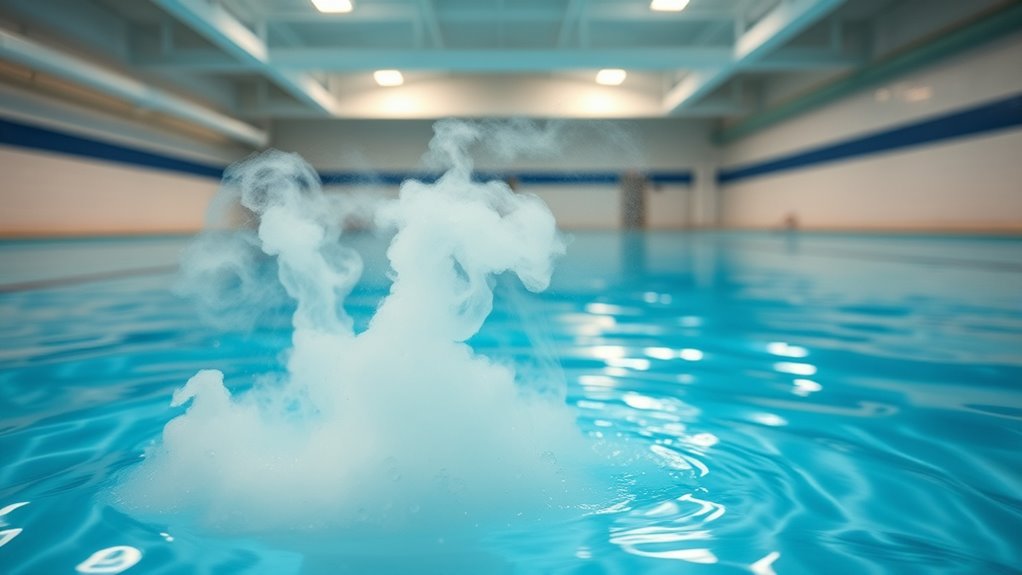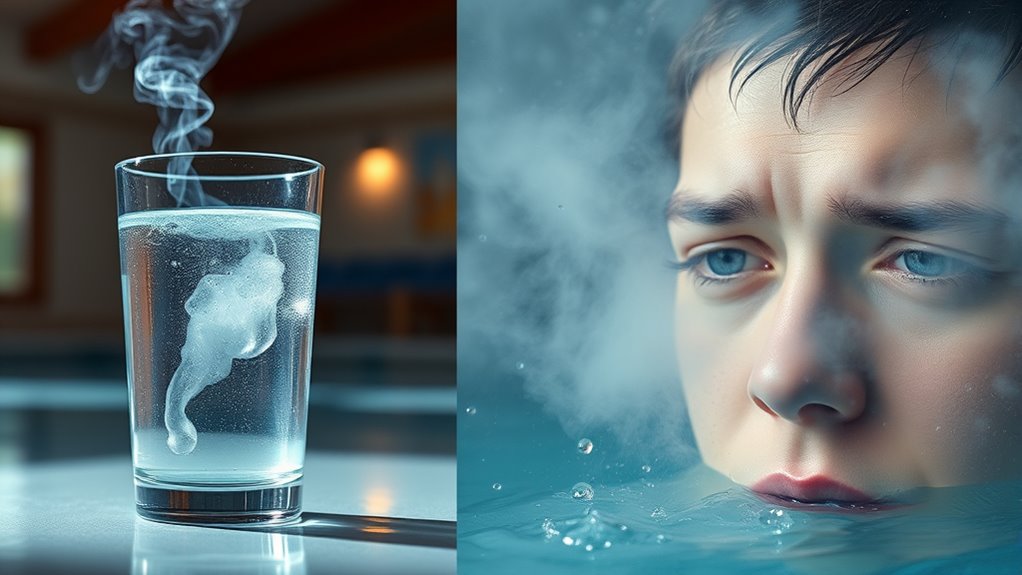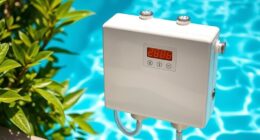Chlorine smells are usually fresh and sharp, coming from disinfected water or pools, and tend to dissipate quickly. In contrast, chloramines emit a stronger, more persistent chemical odor that lingers longer in indoor air. Both can cause eye irritation, but chloramines often lead to more severe and prolonged discomfort. If you’re experiencing ongoing eye irritation, understanding the differences between these chemicals can help you find effective solutions—stay with us to learn more about managing indoor air quality.
Key Takeaways
- Chlorine smells are caused by free chlorine vapors from water disinfection, while chloramines produce a more pungent, persistent odor from combined chlorine compounds.
- Chlorine vapors are generally less irritating at low concentrations, but chloramines tend to cause more severe and prolonged eye irritation.
- Chloramines are more stable and linger longer in indoor air, increasing the likelihood of eye discomfort compared to free chlorine.
- Reducing exposure involves using activated carbon air filters and water treatment systems designed to remove both chlorine and chloramines.
- Monitoring indoor air quality and water sources helps identify and mitigate chemical vapors that cause eye irritation.

Indoor air quality plays a crucial role in maintaining your eye health, especially since many people spend most of their time indoors. Poor air quality can lead to irritation, dryness, and discomfort in your eyes, making everyday activities like reading or working at a computer uncomfortable or even painful. Two common indoor air contaminants linked to eye irritation are chlorine smells and chloramines, both originating from disinfectants used in water treatment and other sources. Understanding the difference between these two can help you identify and reduce exposure, protecting your eyes and overall health.
Indoor air quality impacts eye health; identify chlorine smells and chloramines to reduce irritation and protect your vision.
Chlorine smells are familiar to most people, often detected in tap water or in indoor pools. This gas is added intentionally to disinfect water, killing harmful bacteria and viruses. While small amounts of chlorine vapor are usually harmless, high concentrations can cause eye irritation, especially if you’re exposed to the fumes over a prolonged period. When chlorine evaporates into the air, it can irritate your eyes, leading to redness, itching, and a burning sensation. If you notice a strong chlorine smell in your indoor environment, it’s a sign that you might be inhaling chlorine vapors, which can contribute to eye discomfort.
Chloramines, on the other hand, form when chlorine reacts with organic matter, such as ammonia, which is sometimes present in water supplies or cleaning products. They have a distinct, more pungent smell than chlorine and tend to linger longer in the air. Chloramines are more irritating to your respiratory system and eyes because they are more stable and persist longer than free chlorine. Exposure to chloramines can cause more severe eye irritation, including increased redness, watering, and a gritty feeling that makes your eyes feel inflamed or gritty. Because chloramines tend to stay airborne longer, they can be a more persistent source of irritation in indoor environments where water treatment residues are present.
To reduce exposure to both chlorine and chloramines, you can take practical steps such as using air purifiers equipped with activated carbon filters, which can absorb these chemicals from the air. Additionally, ensuring good ventilation in your home, especially near water sources or indoor pools, helps disperse vapors before they accumulate. Using water filters that specifically remove chlorine and chloramines before using water for cleaning or drinking can also make a notable difference. If you notice persistent eye irritation, consider checking your indoor air quality and water treatment systems; sometimes, the source is right in your home.
Frequently Asked Questions
Can Household Air Purifiers Remove Chlorine or Chloramine Odors Effectively?
Yes, household air purifiers can help remove chlorine and chloramine odors effectively. Look for models with activated carbon filters, as they absorb these chemical odors better than standard filters. You should run the purifier regularly in areas where you notice these smells. Keep in mind, though, that some stronger odors may require a purifier with a higher capacity or multiple filters for ideal removal.
Are There Long-Term Health Effects From Prolonged Exposure to Chloramines?
Did you know that long-term chloramine exposure can increase respiratory issues by up to 20%? You should know that prolonged exposure to chloramines may lead to respiratory problems and eye irritation, especially for sensitive individuals. While research continues, it’s wise to reduce exposure by improving indoor air quality and using water filters. Staying informed helps protect your health over time from potential risks associated with chloramines.
How Do Different Water Treatment Methods Impact Indoor Air Quality?
Different water treatment methods considerably impact your indoor air quality. Chlorine-based treatments release fumes that can irritate your eyes and respiratory system, especially in poorly ventilated spaces. Using activated carbon filters or UV treatment reduces these airborne contaminants, improving air quality and minimizing irritation. Regularly maintaining your water filtration system guarantees safer indoor air, helping you breathe easier and avoid discomfort caused by chemical vapors from treated water.
What Are the Best Ways to Test Indoor Air for Chlorine or Chloramine Levels?
Think of testing indoor air for chlorine or chloramine levels like shining a flashlight into a dark room. You can use test kits, which are simple to use and give quick results, or electronic air quality monitors that provide continuous readings. Swab or air sampling methods are also available for more detailed analysis. Choose a method based on your needs, budget, and how often you want to test.
Do Certain Indoor Plants Help Reduce Chlorine or Chloramine Smells?
Certain indoor plants can help improve air quality, but they don’t specifically target chlorine or chloramine smells. Plants like peace lilies, snake plants, or pothos are excellent for filtering common indoor pollutants, but their effect on chlorine or chloramine odors is limited. To effectively reduce these smells, make certain of good ventilation and consider using activated carbon filters. Incorporating plants can boost overall air quality, but they shouldn’t be your sole solution.
Conclusion
So, next time you notice a strong chlorine smell or itchy eyes after swimming, remember—you’re battling an invisible army of chloramines and chlorine fumes that could turn your indoor air into a toxic nightmare! Don’t let these sneaky pollutants turn your home into a hazardous zone. Take action now—improve ventilation, use proper water treatments, and breathe easy, or risk turning your indoor air into a dangerous, eye-irritating battlefield!









